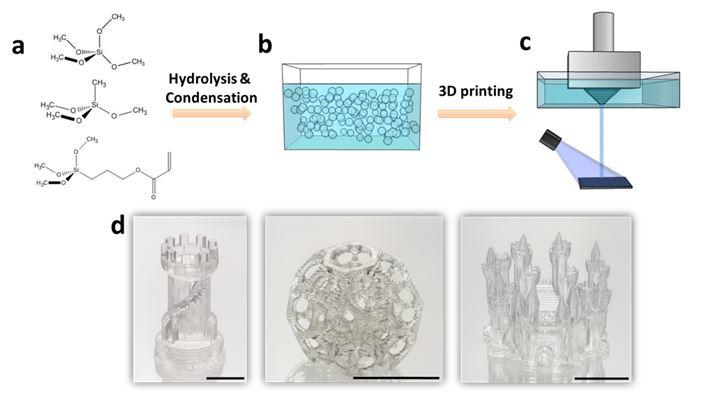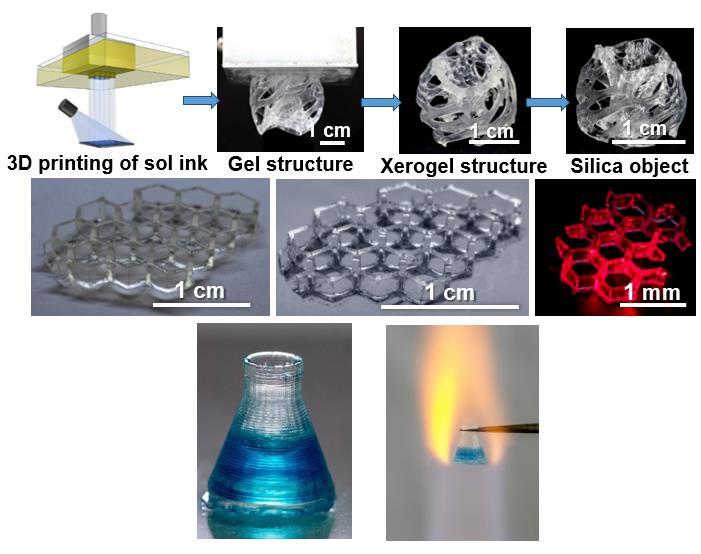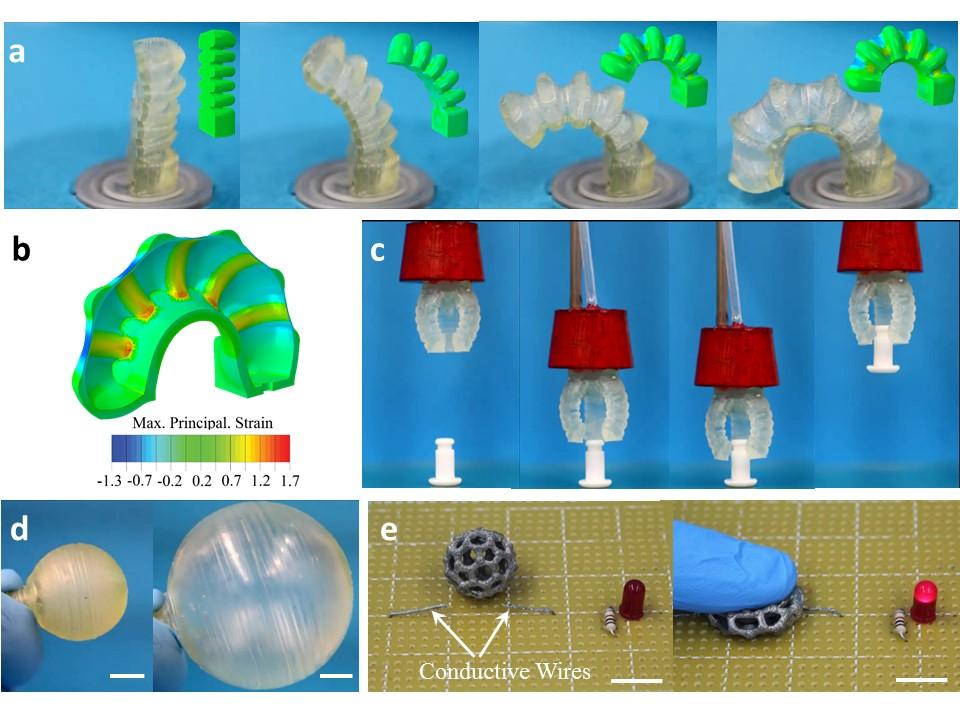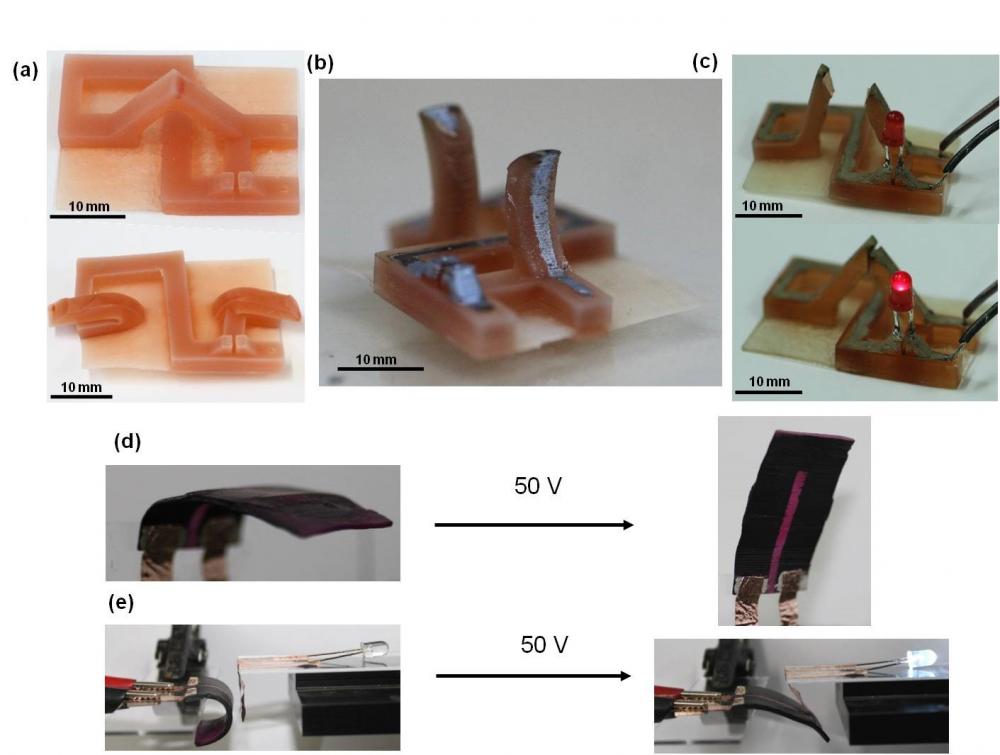The field of additive manufacturing (more commonly known as three-dimensional printing) has developed significantly in recent years, consequently increasing the need for new materials for the fabrication of functional 3D structures. It is currently being used for a variety of applications ranging from modelling to medical devices. Current methods are based on layer-by-layer fabrication of a three dimensional structure, each layer being built by one of the following methods: (1) Fuse Deposition Modelling (FDM) based on melting a material which is typically a polymer (2) Selective Laser Sintering (SLS) based on laser melting of powder particles, (3), Color Jet Printing (CJP) based on jetting a binder onto a powder, and (4),stereo lithography (SLA) which is based on selective curing of polymerizable monomers. A common method for this technique is Digital Light Processing (DLP) which is based on selective polymerization of individual pixels within a thin layer. This is done by using a digital micro mirror device (DMD) that results in small dots (tens of micrometers).
Our research is focused on developing new materials for most types of 3D printing technologies, including conductive inks, ceramic materials and metals, and shape memory polymers. Some of the research activities will be described in the following sections.
3D printed organic-ceramic complex hybrid structures with high silica content
New hybrid organic-inorganic sol gel inks that can undergo both condensation and radical polymerization were developed, enabling fabrication of complex objects by additive manufacturing technology, yielding 3D objects with superior properties. The 3D objects have very high silica content and are printed by Digital Light Processing commercial printers. The printed lightweight objects are characterized by excellent mechanical strength compared to currently used high performance polymers (139 MPa), very high stability at elevated temperatures (Heat Deflection Temperature >270 °C), high transparency (89%) and lack of cracks, with glossiness similar to silica glasses. The new inks fill the gap in additive manufacturing of objects composed of ceramics only and organic materials only, thus enabling harnessing the advantages of both worlds of materials. https://doi.org/10.1002/advs.201800061

3D printing process of sol gel based inks with dual polymerization mechanisms of complex hybrid 3D object (scale bar, 1cm).
Additive manufacturing of transparent silica glass from solutions
We developed an ink composition for 3D printing of transparent silica objects. The ink is based on combining a sol−gel process with photopolymerization for obtaining dense-fused, silica transparent objects. In contrast to recent studies, which used inks based on dispersed silica particles, the sol−gel ink enables us to achieve fused-silica glass at a low temperature, with controlled density and RIs. In addition, control over the density can be realized at the ink preparation step, by enabling the printing of one silica structure with zones of different RIs by a multilateral, 3D printer. Moreover, the new process and the new approach to ink preparation facilitate the fabrication of other metal oxide structures that contain a variety of functional materials. This opens great possibilities in various applications such as optical devices, as well as complex and miniature reactors, including microfluidic devices. DOI: 10.1021/acsami.8b03766

Scheme of printing process and the obtained transparent silica glass objects at different stages. Printed waveguide and miniature flask filled with colored water.
3D printing of responsive hydrogels for drug-delivery systems
We have developed a hydrogel formulation that could function as a model for 3D printed controlled drug delivery system. Hydrogel tablets with complex structures were printed by using acrylic acid as the monomer and polyethylene glycol diacrylate (PEGDA) as a cross-linker, resulting in pH responsive drug-delivery system.
We have demonstrated the utilization of 3D printing to improve performance of classic solid dosage forms by offering new ways to control drug release as function of pH and surface area, while controlling geometry parameters. We have shown a good correlation between the swelling of the tablets and the release of a model drug, meaning we can tune the drug release by designing specific shapes with the desired surface area. It is expected that advancing this technology would eventually allow to provide an important means for personalized drug delivery by controlling critical parameters for drug action and absorption. DOI: 10.2217/3dp-2017-0009

Images of the 3D printed hydrogel tablets using digital light processing technique. (A) Box. (B) Hemisphere. (C) 5 × 5. (D) Hive. (E–F) are scanning electron microscopy images of D and C shapes, respectively.
Highly Stretchable and UV Curable Elastomer for Three Dimensional Printing
We have developed compositions of highly stretchable and UV curable (SUV) elastomers that can be stretched by up to 1100%, which is more than five times the elongation at break of the existing UV curable elastomers and are suitable for UV curing based 3D printing technologies. Using DLP printing with the SUV elastomer compositions enabled the direct creation of complex 3D lattices or hollow structures that exhibit extremely large deformation. For example, we directly printed a soft actuator and a soft robotic gripper which have a complex 3D and hollow structures and can undergo large local deformations (Fig. 1). We also demonstrated a 3D Bucky ball light switch by combining the DLP printing with a silver nanoparticles coating and room temperature sintering process. Overall, the SUV elastomers will significantly enhance the capability of the DLP based 3D printing of fabricating soft and deformable 3D structures and devices including soft actuators and robots, flexible electronics, acoustic metamaterials, and many other applications (The scale bar in the figures in 10 mm). Adv. Mater. DOI: 10.1002/adma.201606000.

Figure 1. Shows different 3D printed structures such as soft actuator, gripper, spherical balloon and electronic switches using SUV elastomer
Porous structures by printing Oil-in-Water emulsions
A new ink was developed for printing porous structures that can be used for embedding various functional materials. The ink is composed of a UV polymerizable Oil-in-Water emulsion which can be converted into a solid object upon UV irradiation, forming a porous structure after evaporation of the water phase. The water phase can contain silver NP that are sintered by a chemical sintering, resulting in a 3D conductive structure (Fig.2). The surface area of the object can be controlled by changing the emulsion's droplets size and the dispersed phase fraction. see: Journal of Materials Chemistry C 1.19 (2013): 3244-3249. and Journal of Materials Chemistry C 3.9 (2015): 2040-2044.

Fig. 2: Printed 3D porous (left) and conductive objects (right)
3D and 4D printing of shape memory materials
Until now, Shape Memory Polymers (SMPs) were not used in the field of 3D printing or flexible electronics due to inadequate processing technologies. We developed a new process and inks which enables printing of oligomer melts in a DLP printer, to generate high-resolution three-dimensional (3D) shape memory structures (Fig. 3). We also demonstrated how these printed structures can be further utilized for constructing flexible electronic devices (Fig.4), see: Adv. Mater.. doi:10.1002/adma.201503132

Fig. 3: 3D printed structures changing shape upon heating due to the shape memory polymer.

Fig. 4: Printed 3D electrical circuit made of shape memory polymers, activated by heat.

